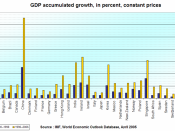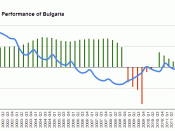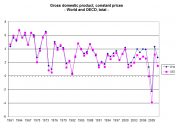Economic Growth.
China.
China is classed by the World Bank as a lower middle-income country. China's real GDP grew at a rate of 9.1% in 2003, up from 8.0% in 2002, meaning that even economic growth is increasing rapidly in China. China's GDP growth rate is even faster than the US, and has enjoyed some double-digit growth rate since it has opened to economic reform.
This rapid growth had brought opportunities and challenges - both for China and for the rest of the world.
- PPP GDP - $6.5 trillion US, second in the world
- PPP GDP/capita - $5 000 US
-GDP - $1.46 trillion US
-GDP growth - 9.4%
-GDP/capita - $1 100 US
- GNI - $1.4 trillion US
- GNI/capita - $1 010 US
- Exchange rate - 8.28 RMB for 1 US, 10.24 RMB for 1 Euro
This is an economy with much catching up to do.
Continued rapid growth will be essential if poverty rates in China are to be reduced further. The challenge for the Chinese authorities is to ensure that growth rates are sustainable over a long period of time if they wish to continue reducing poverty rates in the country.
But China is undergoing some major and sometimes painful restructuring, due to:
- Larger gap between rich and poor
- Large debts to pay off to several countries
Australia.
Australia has an enviable Western-style capitalist economy, with a per capita GDP on par with the four dominant West European economies.
Since the recession in 1990-91, GDP has grown in Australia every year. Growth in 1991-92 was relatively low (0.3%), by 1995-96 it had accelerated to 4.2%, a growth rate which was generally maintained until 1999-2000. GDP growth has fluctuated since then, at 2.0%, in 2000-01, 3.9% in 2001-02 and 2.8% in...


